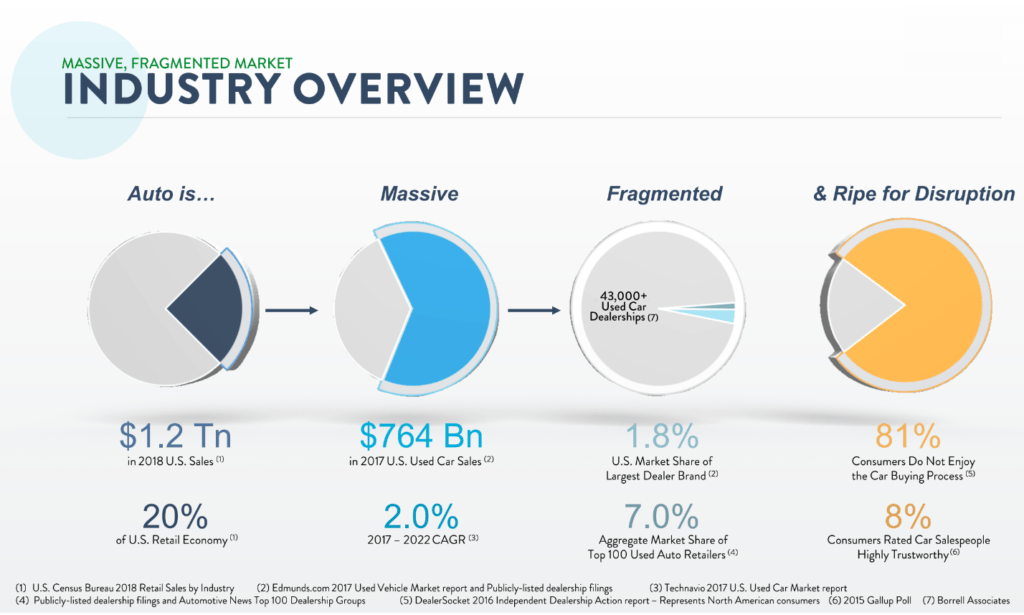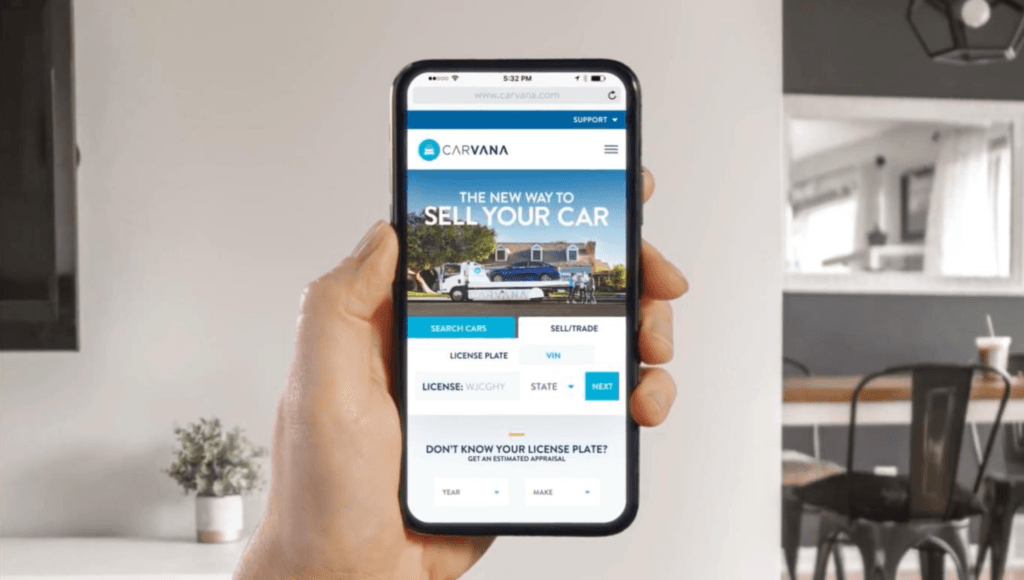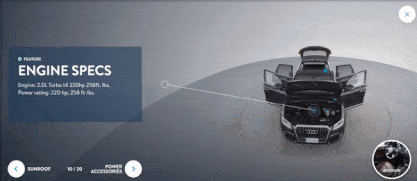Carvana:The new way to buy a car

Carvana is an online e-commerce platform for used cars. The company bypasses the traditional dealership infrastructure and uses astonishing marketing strategies to attract customers: Car vending machines, Youtube advertising campaigns, 360-patented technology, etc.
The U.S. used car market
The U.S. used car market remains a major leader of the American economy In 2018, over 40 million used vehicles were sold in the United States [1], which translates to approximately one used car bought for every 6.3 Americans that year. However, this market is still very fragmented and inefficient – more than 43,000 dealerships in the U.S.- and the buying experience is often a hassle.
This experience often involves facing a pushy salesman, a limited selection of cars at the dealership, uncertainty over the car’s quality and history, and limited financing options. Studies have shown that 81% of consumers do not enjoy the car-buying process [2], and only 8% judge the salespeople are highly trustworthy [3]. Overall, this amounts to a real “buyer beware” situation for an industry strongly in need of modernization.
Carvana: A peer-to-peer marketplace for used cars
Founded in 2013 in Tempe, Arizona, as a spin-off of the car reseller DriveTime, Carvana was born with the intention of revolutionizing the used car industry. The company defines itself as a direct-to-consumer, used-car-only retailer. Its intentions are to bypass the traditional dealership infrastructure, to create a business model with reduced overall costs and to pass the savings on to the consumer through lower prices with no hidden fees and a better customer experience.
A revamped customer experience powered by improved operations
With the focus to improve the whole customer experience, Carvana’s founders successfully brought digital innovation to the industry. In the most recent quarter, Carvana posted incredible yearly revenue growth of 108% and total gross profits of $137.8 million. This represents an increase of 181% compared to Q2 of 2018 and the company’s 22nd straight quarter of triple-digit revenue growth [4].
The company applies new technologies both to improve its online platform and its operational network. The key elements of Carvana’s differentiation are listed below:
- Car acquisition: Carvana developed a proprietary vehicle-acquisition algorithm to optimize its holding inventory to fit customers’ needs. Some of the inputs are car-quality screening and demand forecast, through historical data and clickstream.
- Car availability: As of September 20, 2019, Carvana lists 20,000+ cars on its platform. With only 11–100 cars available at typical dealers[5] Carvana clearly surpasses the traditional used car industry on the point of car availability.
- Expert network and patented 360-degrees digital tour: Carvana offers 360-degree used vehicle digital tours to its customers. These high-definition photos highlight features, imperfections, and detailed interior and exterior views of every vehicle, giving customers a transparent virtual vehicle tour experience.
- E-commerce: Carvana value lies on its e-commerce platform. Thanks to its intuitive user interface, any purchase can be completed within 10 minutes online once a car is selected.
- Financing platform: Carvana offers auto loans to its customers, breaking down the financing barrier and diversifying its revenue sources. This service makes it easier for customers to gain access to personalized financing terms without hurting their credit score.
- Pick-up and delivery: Carvana owns an in-house logistic network. Cars can be delivered to as early as the day following the purchase. To complement its logistic network and offset some of the costs of delivery, Carvana also encourages customers to pick up their cars in one of Carvana’s proprietary “car vending machines” offsetting up to $200 from customers’ travel fares and boosting word of mouth. In both scenario, the company offers its customers a 7-day Money Back Guarantee.

- Marketing through social media: Carvana employs digital technology to market its services to the public. While the company publishes trendy and targeted marketing videos online (see “That didn’t suck” video below), it also enjoys the benefit of word-of-mouth marketing. Indeed, many customers like to share their experiences online, as there are numerous videos on YouTube of customers picking up their cars in vending machines or receiving outstanding delivery services.
https://www.youtube.com/watch?v=XEKNWES2_4k
Carvana: the Amazon of cars?
Carvana is rapidly growing its service offerings, hoping to become net positive in the coming years and to be able to compete with its main rival: Carmax. It is interacting with more customers and scaling operations to support its 95% growth in retail sales by bringing its expected end-of-year coverage to 140–145 markets and its total U.S. population coverage to approximately 67% [4].
However, the company’s net loss also seems to grow proportionally: in the latest quarterly report, Carvana’s net loss was $64.1 million, an increase of 25% year over year. In this new digital market where companies are growing at any cost to grab as much market share as possible, it is unclear where Carvana will end up in a few years. One thing is certain: its contribution and impact on the U.S. used car market are undeniable.
Sources:
[1] Static.ed.edmunds-media.com. (2019). Used Vehicle Outlook 2019. [online] Available at: https://static.ed.edmunds-media.com/unversioned/img/industry-center/insights/2019-used-vehicle-outlook-report-final.pdf [Accessed 21 Sep. 2019].
[2] Dealer Socket 2016 Independent Dealership Action report – Represents North American Consumers
[3] 205 Gallup Poll
[4] Carvana Letter to Shareholders Q2 2019
[5] 2016 NIADA Car Industry report






We’ve seen several car transfer companies like this one the past (Carmax, Shift, etc.) it’ll be fun to watch the market shake out. Seems like this company is growing rapidly but at a decent cost in terms of losses.
Carvana appears as case example for outstanding use of advertising messaging. Their discourse in its messaging narrative is centered at elevating customer pain-point and positioning itself as the solution. I found it to be very persuasive.
I have never purchased a car online but I did purchase a 2013 Harley Davidson Softail on eBay in 2015. Overall, my experience was very positive, but there were several pain points that could have been made easier. For one thing, I had to use a third-party escrow service to hold the money while the vehicle was in transit. And, speaking of transit, I had to arrange for third-party shipping from U-Ship (another very interesting tech company disrupting an traditional space). It would have have been tremendous if both of these third-party services were provided by one company. Finally, a few words about trust. In the beginning of the negotiating process you have to be careful because you can’t be sure that the seller in a market like eBay is trust-worthy. Most sellers are but you should never assume. Ebay’s feedback and reputation tools are great but if I could trust a single source of truth, providing high-quality documentation of the vehicle’s highlights AND flaws, combined with a 7 day money back guarantee, then I would feel safer from the first moment.
You point out that Carvana makes a net loss which seems to grow proportionally to revenues. I believe the company is a good example for a trend I have observed over recent years, especially in the US. While Carvana’s business model is essentially buying and selling cars—a very tangible exercise—it is presented and valued as a digital business model. In class we pointed out, that the benefit of a digital business model is its scaling at essentially zero cost. However, for Carvana’s business model, this is not true. As I understand it, the company provides services (financing, delivery, expert advice, etc.) which are characterized by a high share of variable costs which only marginally decrease with increasing company size. Thus, I regard the company as an offline business supported by digital tools, not a truly digital business. However, an offline business which does not scale at close-to-zero costs should be bankrupt by now, if it has not generated any net profits. A similar example is Uber which still has negative unit economics.
Great read; thanks Matthieu! Really curious about how this digital platform will fare. Given the product and market, Carvana is handling most of the operations. As a consumer, I would want to test out a vehicle on premise before making a commitment to buy. It’ll be interesting to see how Carvana can scale and how it will be able to manage the offline experience that most customers would want before making a major purchase.
Great post! This is an interesting business. I agree with a couple of points that have already been made in the comments here. My own sense is that something is lost when the consumer cannot test drive a used car before making the purchase… even with such detailed reporting on the condition of the car, it can be hard to know how it drives, etc. However, your research suggests that there are plenty of people who feel differently and prioritize convenience (and/or the Instagram-worthy “car vending machine” moment). I am also wary that this business is trying to present itself as a technology platform, when it is still asset heavy. Carvana may have eliminated some of the overhead associated with a car dealership, but I would think IT expenditure, customer service and logistics costs are significant.